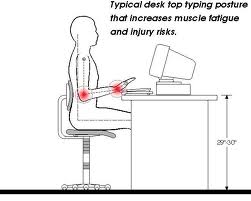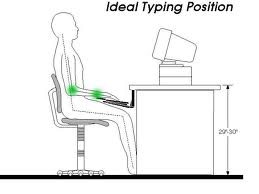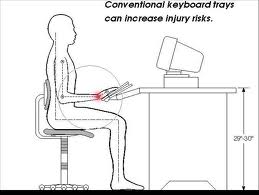Setting the Proper Heights for the Treadmill Desk Surface and Keyboard Tray

You’ve finally done it: after years of back-breaking, hunched-over desk work, you’ve made the switch to an adjustable-height treadmill desk and are ready to start walking your way to better health. But before you step on that treadmill, you ask yourself: how high should my desk be?
A common answer for this has been to raise your desk so that your arms are bent at a 90-degree angle when you type. This is a partial solution: a 90-degree angle keeps your wrists straight when you type (assuming your keyboard is level with your desktop) and helps prevent the wrist strain and injuries that come from improper wrist posture. However, maintaining this right angle for long can put a strain on the flexors of your forearms, especially if you don’t have a cushion to wrest your wrists on, substituting one type of pain for another. That is why keeping your arms in a neutral position when you work is the most ergodynamic solution which is gonna change between when you are sitting and standing.
In Space, No One Can Hear You Complain About Your Wrist Ergonomics
The easiest way to picture our most “neutral” position is to think about how astronauts’ arms hang when they’re floating in their sleeping bags aboard the International Space Station – their arms relaxed at a shallow angle, with their wrists straight. This natural “Sleeping Astronaut” position keeps your arms at a comfortable angle, with little muscle flex in your forearms and wrists.
As you can guess, most desk surfaces are too flat to facilitate this kind of ergonomic posture – hence, the 90-degree rule to keep wrists straight. A few desks, like the iMovR Lander w/SteadyType and iMovR Jaxson Corner, include a desktop portion that can adjust to a negative angle to create better wrist position necessary to type more comfortably. With these ergonomic workstations, your ideal desk height will be much lower than elbow level – the Omega desks, for example, position your keyboard close to your belt line, where your hands naturally fall when you stand. This will have to be adjusted when the desk is in the sitting position, as that might put some ergonomic keyboard trays jamming into your knees or lap, necessitating a slightly different angle where you can lay your wrists on pads or use chair arm rests.
Other workplace tools that can affect the height of your desk include ergonomic keyboard trays, which also tilt at a negative angle: the Stowaway, for example, affords 20 degrees of negative tilt in addition to 7″ of vertical adjustment. Our favorite trays have an even wider range of tilt. Read more about the SteadyType Exo and SteadyType Slide from iMovR to see an example of a keyboard tray that can adjust to the ideal position for any user, whether they are sitting or standing.
Depending on your particular tray, you may find it best to work with your wrists above or below the desk top. Ergonomic keyboards like the Microsoft Sculpt, Matias Pro or Kinesis Freestyle can also change the ideal height of your work surface, adding a couple inches here and there. It’s important to think about all of these additional height factors when considering your next standing desk.
Once your workstation is set up, take some time to familiarize yourself with working at different heights. Find a configuration that keeps your wrists and arms as straight as possible. As always, listen to your body: If you begin to feel stiff, adjust your desk up or down a skosh to reduce some of the strain that comes from staying in the same position. There’s no one proper standing- or walking height, so feel free to experiment with your desk to find what works for you.
Another important side-effect you need to consider with your desk height is stability. The more neutral position you can achieve while typing will mean that you won’t need to use as much force to move and stabilize your hands and fingers as you hit the keyboard. And when some standing desks already have problems with shaking, you will want to minimize how much movement happens in your desk, and then in your monitors as well.
Other Tips for Stand Up Desk Ergonomics
- The chest should always remain open, shoulders back, as much as possible
- The upper arms should be kept as close to the body as possible
- The wrists should not be pronated (turned down) too much
- The wrists should rest comfortably on a soft cushion to “anchor” the hands from the gentle swaying motions of body, without placing too much pressure on the contact point.
- The front of the keyboard must be higher than the back of the keyboard by anywhere from a few degrees to as much as 30 degrees, depending on what feels comfortable for you in either walking, standing or sitting position. The best way to achieve this is with an under-desk keyboard tray.
- While your wrists should rest at a shallow angle, your hands should not be in a perfectly straight line with the forearm. Instead, they should tilt up a few degrees for best use of the small muscles in the hand. Too much of an angle, however, will result in carpal tunnel constriction. Think of it this way: the point where the fingertips touch the keys should be in a straight line with your forearm.
- Using an ergonomic keyboard that keeps the hands further apart and with the thumbs higher than the pinkies is also very important for keeping the chest open, shoulders back, and avoiding the rounded hunch posture.
-

A properly positioned monitor arm will help avoid strain on your heck and back. The height of the desk will also affect how you use an adjustable monitor arm, especially if you have a large setup on an electric monitor arm like iMovR’s Emma. Check out the full roundup of monitor arms for more detailed info on how to use them with your adjustable height des.
- The mouse or trackball should be located as close as possible to the body. Over-reaching for the mouse will place undue strain on the shoulder and it will exacerbate “pivoting” on the spine, which can result in interesting back pains.
- See illustration for the proper angles. Set your desktop height to the appropriate level to attain these angles.


Of course, as technology and innovation moves forward we will likely find even more solutions to help reduce stress injuries over time. Inventors are developing new ways to type even without a keyboard. But we try to find the best information for you to get the best ergonomic setup possible. This presentation on office ergonomics will have even more for you to read and share. If you can type by just tapping your fingers on a bare tabletop, your lap, or any surface, lots of these problems might be avoided in the future.
If you want upgrade fully to a treadmill des and want to make sure it will work for you, you should read our article on guidance to see how you can test one out for yourself.



0 Comments
Leave a response >